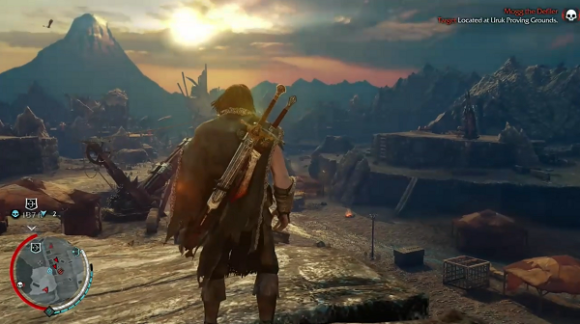
To understand what makes Shadow of Mordor interesting, and in some ways very good, I have to go back to Hero Quest.
Hero Quest was/is a board game that incorporated light roleplaying in a dungeon where each player took on the role of a broad fantasy stereotype (Barbarian, Mage, Rogue etc.) and traipsed along squares, fighting monsters, completing quests and gathering loot as they went. It was simple but compelling and came with a series of premade missions that opened up the imagination for what could be done with a simple grid and a few dice with different pictures on them.
In one of the game’s stories the team is tasked with killing an Orc chieftain called Ulag. The group I was hosting went in and slew him pretty quickly, but for some reason I took a shine to his nondescript plastic piece and was disappointed that he was out of the game.
So, I devised a new quest: Ulag’s soul was too desirous for life and he crawled back into another host. His will was so powerful that when that host died he could switch to another. As a result, the team had to go on a McGuffin quest to find the only thing that could kill his dispossessed ethereal form.
Personally pleased with the build up and with an Ulag that was more powerful, I let the party go on the quest only to be instantly dismayed by how quickly they almost dispatched him. At the last minute I devised a way for him to escape so that he could show up further times and harass the party. He became the ‘big bad’ of their adventures, and each time he got a little tougher and had few more tricks up his sleeve. On each occasion, the party of my friends would beat him with Ulag only narrowly escaping. I was protective of the ugly greenskin and my affection for him grew with each encounter. What I didn’t realise, or chose to ignore, is that as my fondness for my creation increased, my friends grew to hate him more and more. It got so bad that, on what would have been the final quest, Ulag almost damaged our friendship beyond repair. Such was our mutual investment in a piece of plastic and paper.
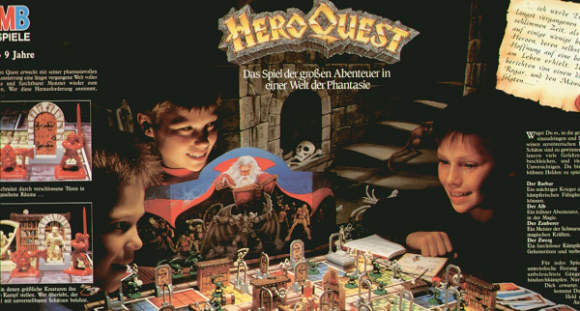
Go fuck yourself
This is what ends up being the standout aspect of Shadow of Mordor. Unfortunately, it’s not something that is immediately clear when you begin playing.
Dropped into a small open-ended map, you adopt the role of a ranger who is tasked with identifying a group of Uruk captains and then killing them. There is a preamble of a story but it is fucking rubbish.
The traversal required to get to these tasks and the combat that ensues is underwhelming. Shadow of Mordor has adopted the one-button approach of holding down a button while you watch your avatar perform derring-do. It manages to be both obscure – you never feel like you fully understand where your character going to jump/drop/sprint next – and overly condescending – sure, you look awesome doing what you’re doing but your involvement is pretty much reduced to that of a bystander. The combat is a mindless series of button spamming, interrupted sporadically by pressing another button to parry incoming attacks; it makes the latest Dynasty Warriors look nuanced. Each animation is beautifully rendered and animated but, despite the various ways of getting into trouble when overwhelmed, I don’t understand how anyone could actively enjoy it. It manages to be lacking in depth and also lacking in empowerment, so that you end up going through rote actions, waiting for your combo meter to get high enough to trigger another grisly kill.
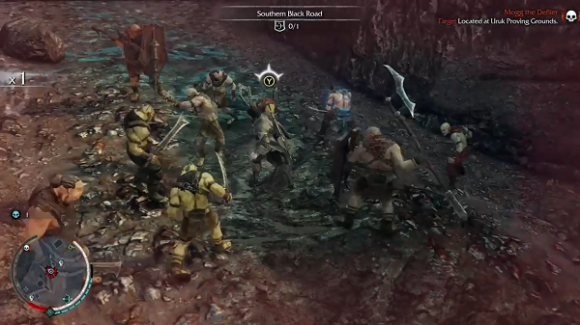
In the opening hours and the first few story missions it is hard to see why it would be worth playing the game further, but it does start to reveal its delights.
Each Uruk captain and, later, Warchiefs will patrol the map, meaning that each encounter with them becomes random as you try to complete more of your tasks. Each of them has different strengths and weaknesses and an accompanying set of stats; they will complete their own missions that will allow them to level up and, occasionally, they will fight each other and create changes in the hierarchy.
You’re able to seek out information on these weaknesses and strengths which will help you figure out how to kill them. You might find that they are vulnerable to stealth attacks, or that they are terrified of a particular type of one of the many species of wildlife dynamically wandering through the world. Once that’s done, if you’re feeling particularly cocky you can just go for them without the preamble. You track down your target, kill them and then work up the chain.
Apologies for taking so long to get to the good bits. I will endeavour to explain further through an anecdote. I met a lowly Uruk captain called Prak Fast Feet reasonably early on. He was a spindly runt that favoured an explosive crossbow (the arrows shot from it were explosive, not the crossbow itself). He wasn’t my main concern as I had a bigger problem in the form of this other guy they called Kaka the Brave. He was tough and so I gave Prak no mind when he introduced himself. I totally underestimated them and Prak shot me in the back as I tried to escape.
On re-spawning I was notified that both Prak and Kaka had been promoted and levelled up as a result of killing me. They did a little celebratory roar and got better armour just to mock me.
I went after Kaka again, only for a no-name git to get me and succeed in getting himself promoted (as well as added to my shit-list). Prak auto-completed a mission at the same time and grew stronger – it was particularly galling to know that if I hadn’t died I might have been able to intervene and stop him. Instead, I now had two much tougher opponents to face.
I tried to attack Kaka one more time and was killed by yet another grunt who then got his chance to become a captain. After having whittled down their numbers earlier I was swelling their ranks with my own stupidity and making two powerful opponents: Prak and Kaka.
More determined than ever to put a stop to this series of misfortunes, I noted that Prak was out on a hunting trip and chose to go and sabotage it. I successfully managed to stop him being victorious but in the ensuing carnage (he had an ability that allowed him to summon nearby minions) he managed to escape.
I focused instead on the story missions after that series of botched sorties. Incidentally, the story missions are all universally terrible and can be best described by the Clerks 2 rant.
Much later I did get my revenge; the two grunts met grisly ends. I hunted down Kaka and helped him meet his maker in a run-down fort surrounded by the bodies of his inept guards. I finally caught up with Prak and gutted him, too. However, he kept coming back. The first time was unpleasant as it was just after a hefty battle with a Warchief that left me without arrows and low on health. Prak came in and the standard intro sequence ran, but with this he was now sporting a horrific scar over his eyes.
“Look what you did to my face!†he snarled.
I managed to take him down but he came back again and again, each time more damaged and more pissed off.
Our final showdown, some ten hours after the first time we encountered one another, was more satisfyingly climatic than the game’s limp QTE-injected finale, and by that time I had fully grown to hate Prak for his doggedness.
It is a beautiful system that produced this, from the distinct barks of the Uruk captains and Warchiefs (the developer, Monolith, must have recorded hundreds of different ones), which rarely repeat and help to make it feel more personal, to the distinct designs and garbs that mean the Uruks feel tailored to your playthrough.
That they successfully recognised the frustration that Prak caused and to then build on it to the point that I can still feel a loathing for the name of my nemesis is impressive.
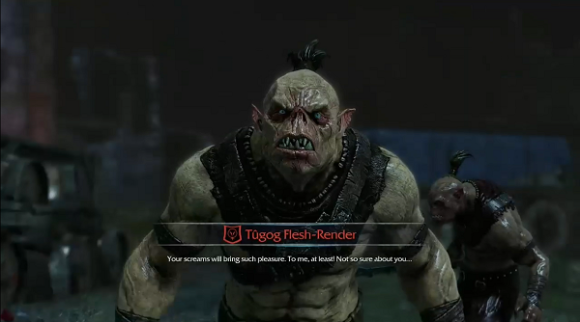
As already stated, the mechanics of traversal and combat are average and they get even less entertaining as new abilities render the challenges redundant. The second map that’s unlocked halfway through the game introduces new abilities that make everything so easy that you feel like you are just going through the motions.
Still, when the game is allowed to breathe it can offer riveting emergent storytelling. This is something that I hope the development team reinforces in the inevitable sequel. Because everyone deserves to have their own Ulag.
Fuck you, Prak.
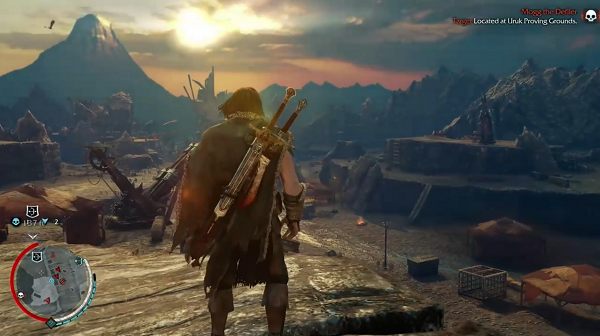
Comments
One response to “Middle Earth: Shadow of Mordor”
So, I have now played Shadow of Mordor! I agree with parts of your review, but not all.
On traversal and movement: I completely agree. It's exactly as I remember Assassin's Creed behaving, and exactly as dull. The two things I will say about it are that getting about is quite rapid as a result, which is good, and that the 'universal parkour' approach does make it easier to scramble about level geometry during stealth approaches or chaotic fights.
Overall I think I'm okay with this, since while simply getting about is very dull, I appreciate the simplicity of it during combat and stealth sections when my attention is focused on enemy positions, potential threats, tactical decisions etc.
On combat: I'm not sure if we've ever really discussed the Arkham games, so I don't know what your take on those is, but SoM reminds me far more of Arkham City than it does Assassin's Creed (I've only played a bit of the 1st AC). It's not as taut as Rocksteady's system: strikes don't have the sense of force and impact, and it's rare that you get into the same rhythm and flow as was possible in the Batman games (particularly once the Berserker and Defender uruks have shown up, as they're highly disruptive – hunters, too, to a lesser extent).
Still, I don't think the combat is as mindless or button-mashy as you describe. You also say you've died a lot. I've died once only, in 15 hours / 65% completion so far, including killing several dozen captains and warchiefs, which suggests to me that we are approaching the game differently. I move about a lot, using jumps to briefly stun berserkers and defenders and get close to hunters, and only attempting a few basic attacks before I counter or jump-move again. I use stun sparingly, as it has a longer animation wind-up than attacking, and leaves you vulnerable unlike jumping. If I am badly wounded or have used a last chance, I back out and hide or find herbs. All of this, to me, makes for a fun combat system with entertaining offensive and defensive mechanics, demanding that you make good use of the environment around you, and be aware of the enemy types surrounding you and where their numbers are thickest.
There are definitely issues with the combat. It's annoying that your branded uruks are vulnerable to your strikes (I don't think outcasts are?) and can even be directly struck (though it's possible this was intentional, as a combo-building strategy). The uruks also look similar in a big scrap; defenders are easiest to spot thanks to their weapons, and hunters due to their build, but in the heat of a fight berserkers look identical to regular uruks to me. Since they've been introduced I've not really been able to build up the same huge combos as previously, which is a real shame. As Dylan pointed out to me the other day, it's also daft that your execution strikes can be interrupted leaving the targets unharmed after you've seen your character stab them multiple times.
Despite all that I like the combat system and look forward to the point when I'm sufficiently used to berserkers that I can rack up huge combos once again. Getting into that zone was beautiful in Arkham and it's wonderful here too.
The nemesis system is tremendous fun and I'm enjoying it a lot. It's definitely the game's most interesting feature. For all that I actually like the combat, it has been done better elsewhere and is not innovative. I wouldn't go so far as to call SoM middle of the road, but I will say that it is a very competently made game that is a lot of fun, that I will think back on fondly but not single out for great praise.
The Clerks rant is somewhat undercut by the manchild going on about how brilliant Star Wars is. It's all a bit https://www.youtube.com/watch?v=5PDdR6LLCmY